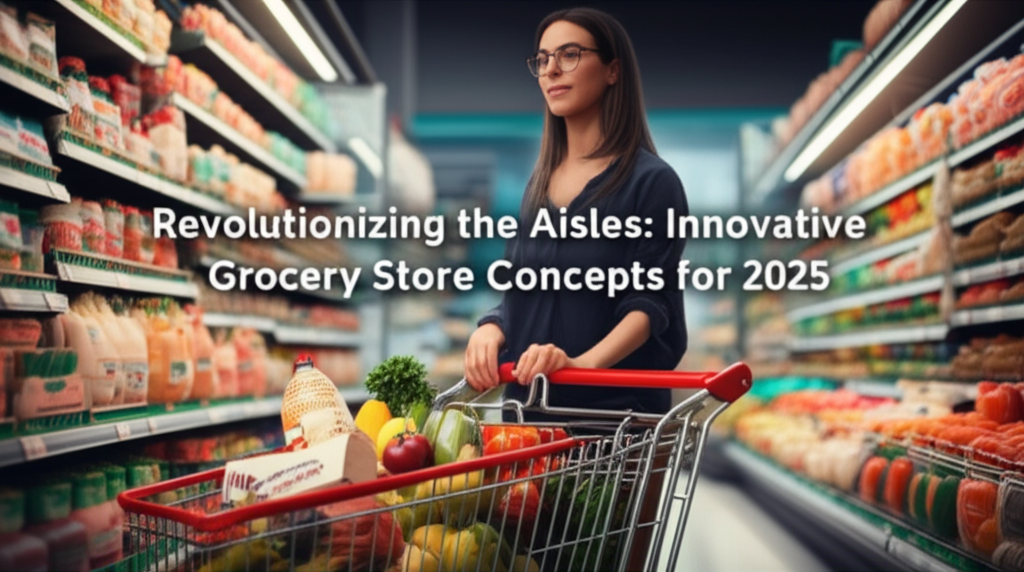As consumer habits evolve and technology advances, grocery stores are on the brink of a major transformation. The grocery shopping experience, traditionally characterized by aisles filled with products, cash registers, and stock shelves, is being reshaped by a convergence of technological, environmental, and social trends. As we move toward 2025, grocery stores will not only adapt to changing consumer needs but also innovate to create unique experiences that engage shoppers in unprecedented ways. This article explores innovative grocery store concepts expected to revolutionize the aisles by 2025.
A Shift in Consumer Behavior
The Rise of Online Shopping
The shift from traditional brick-and-mortar shopping to online platforms has accelerated, especially due to the COVID-19 pandemic. Consumers are increasingly seeking the convenience of shopping from home. This trend has forced grocery stores to rethink their operations and how they connect with customers.
Health and Wellness Focus
Today’s consumers are more health-conscious than ever. They seek fresh, organic, and locally sourced products that align with their lifestyle. This focus on health and wellness will influence product offerings, store layouts, and in-store experiences.
Sustainability Matters
With a growing concern for environmental issues, shoppers are prioritizing sustainability. They want to understand the origin of products and seek stores that promote eco-friendly practices. This consciousness will drive innovation in grocery store concepts, from product sourcing to packaging.
Technological Integration
Smart Carts and RFID Technology
As grocery stores evolve, innovations like smart carts equipped with RFID technology may become the norm. These smart carts can automatically scan products as they are added, allowing for a seamless checkout experience. Shoppers might receive real-time updates on their total spend and even personalized suggestions based on their shopping habits.
Augmented Reality (AR) Experiences
Imagine walking through a grocery store and using your smartphone or smart glasses to receive information about products in real-time. Augmented reality can offer nutritional information, recipes, and even virtual cooking classes while shoppers navigate the aisles. This technology not only enhances the shopping experience but also empowers consumers to make informed choices.
Inventory Management via IoT
The Internet of Things (IoT) will revolutionize inventory management in grocery stores. Sensors can monitor stock levels and expiration dates, alerting managers when to reorder products or remove items from shelves. This not only reduces food waste but also ensures that shelves are always stocked with fresh items, improving customer satisfaction.
Reimagined Store Layouts
Experience-Centric Layouts
In 2025, grocery stores may transform from mere product repositories to experience centers. Store layouts will focus on engaging customers through destinations rather than aisles filled with products. Sections of the store might be dedicated to culinary experiences, offering cooking demonstrations, tastings, and workshops that inspire customers to try new recipes.
Community Spaces
To foster a sense of community, grocery stores may incorporate social spaces within their design. These areas could accommodate seating, cafés, and community bulletin boards, encouraging people to gather, share ideas, and build connections. Spaces for local artists to showcase their work or host pop-up markets can further enhance this community aspect.
Modular Design
Modular store design could become a staple as grocery chains experiment with different layouts and themes. Stores might feature movable shelves and adaptable sections that can be reconfigured based on seasonal products, community events, or changing consumer trends. This flexibility allows grocery stores to keep the shopping experience fresh and dynamic.
Personalized Customer Experiences
Data-Driven Personalization
As grocery stores collect more data on consumer behavior, personalized shopping experiences will become increasingly common. Stores may use apps to send tailored promotions or recommend products based on past purchases. This data can also help create customized shopping lists, improving efficiency for busy consumers.
Loyalty Programs Reinvented
By 2025, loyalty programs are likely to evolve beyond simple discounts. Stores may introduce gamified loyalty experiences, where customers earn points through various activities, including social media engagement, participating in challenges, or even attending store events. This approach aims to deepen customer relationships and drive engagement.
AI-Powered Shopping Assistants
Artificial intelligence will play a significant role in grocery shopping, enabling virtual shopping assistants that guide consumers through their lists, recommend healthier substitutes, or suggest complementary items based on their choices. These assistants may be accessible through in-store kiosks or customers’ smartphones.
Sustainable Practices
Zero Waste Initiatives
As consumers become more eco-conscious, grocery stores will be compelled to adopt zero-waste practices. This includes initiatives like bulk food stations where shoppers can refill containers instead of purchasing pre-packaged items. Stores may also feature composting stations and recycling centers to encourage responsible waste disposal.
Sustainable Supply Chains
In 2025, grocery stores will likely prioritize transparency in their supply chains. Shoppers will demand information about where their food comes from and the practices involved in its production. Stores might showcase local producers, farmers, and artisan products, creating a sense of community and supporting the local economy.
Eco-Friendly Packaging
As part of the commitment to sustainability, grocery stores may push for eco-friendly packaging innovations. This could include compostable materials, reusable containers, and reduced plastic use. Shoppers will appreciate brands that align with their values, ultimately driving sales and loyalty.
Unique Product Offerings
Local and Regional Products
As shopping habits shift, grocery stores will increasingly feature local and regional products that resonate with consumers. This focus not only supports local economies but also enhances product freshness. By 2025, special sections may highlight seasonal products, allowing shoppers to experience the flavors of their region.
Plant-Based and Alternative Proteins
The plant-based movement is here to stay, and grocery stores will respond by expanding their offerings in this space. By 2025, expect stores to dedicate entire sections to plant-based proteins, alternative dairy products, and innovative snacks that cater to health-conscious consumers looking for sustainable solutions.
Global Cuisines and Fusion Food
The multicultural nature of modern society will find its way into grocery stores. By 2025, expect a diverse range of products that reflect global cuisines. Grocery stores may include international sections, featuring ingredients for various culinary traditions, allowing shoppers to experiment and engage with different cultures’ food.
Enhanced In-Store Experiences
Interactive Culinary Stations
Food sampling will become an interactive experience in 2025. Stores might feature cooking stations where trained chefs demonstrate new recipes or offer tastings of unique ingredients. These stations can provide educational value, allowing shoppers to learn about preparation techniques, flavor pairings, and nutritional benefits.
Wellness Centers
As health continues to be a priority, grocery stores may establish wellness centers that provide resources like nutrition counseling, meal planning, and fitness classes. These centers create a holistic approach to health and wellness, using the grocery store as a hub for community well-being.
Events and Workshops
Grocery stores may become venues for community events and workshops, ranging from cooking classes to food festivals. Shoppers can gather to learn new skills, connect with local producers, and cultivate a sense of community around food.
Challenges and Opportunities
Adapting to Change
While the future of grocery stores is filled with potential, there are challenges to navigate. Traditional stores will need to adapt to the rapid developments in technology and shifting consumer behaviors. Some stores may face difficulties in funding these transformations, requiring innovative partnerships or funding models.
Competing with E-Commerce
As online shopping continues to grow, brick-and-mortar stores must provide unique value that cannot be replicated online. This may lead to a redefinition of the in-store experience, focusing on engaging interactions, personal connections, and memorable experiences that drive foot traffic.
The Workforce of the Future
The transformation of grocery stores will also require a skilled workforce trained to operate new technologies, engage with customers effectively, and create personalized experiences. Companies will need to invest in training initiatives and possibly rethink their employee roles to meet the demands of modern grocery shopping.
Conclusion
As we look toward 2025, the grocery store experience will be marked by innovation, personalization, and community engagement. From advanced technological solutions that simplify the shopping process to immersive experiences that bring people together, the grocery aisles will be revolutionized in exciting ways. The successful grocery stores of the future will be those that embrace these changes, engage with consumers on multiple levels, and prioritize sustainability and wellness. Through these transformations, grocery stores will not only serve as places to purchase food but will become vital community hubs that celebrate culinary diversity, foster connections, and contribute to a healthier planet.
In a world where convenience and experience intersect, the grocery store will redefine its purpose, striving to create spaces that are not just about shopping for necessities but about enriching lives, one visit at a time.

